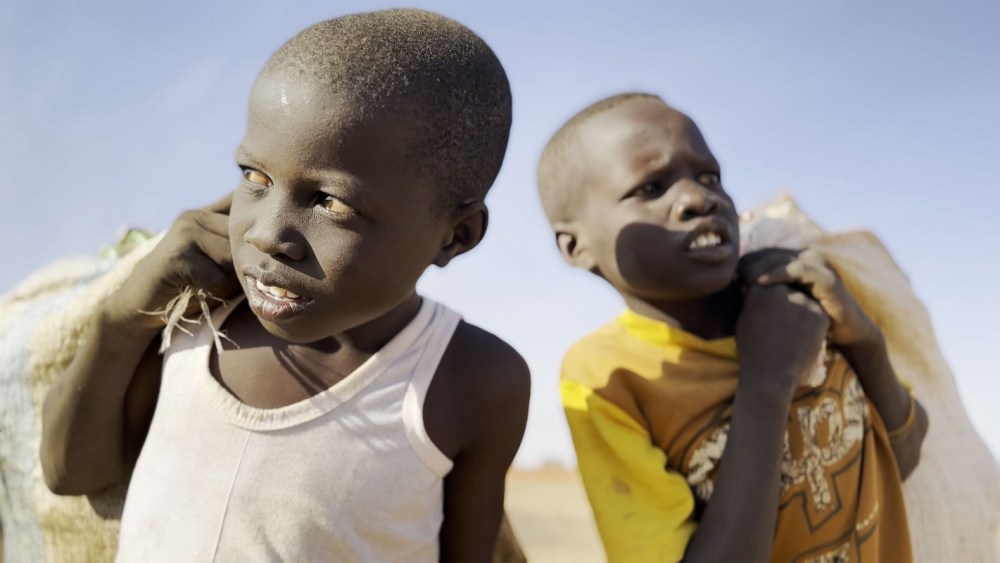Capturing an Embattled City With Ingenuity
In “Khartoum,” five protagonists and four filmmakers tell the story of a city brimming with such life that even a long and vicious war could not dim it. The filmmakers started making “Khartoum” before the war broke out in April 2023. When all of the participants were forced to leave Sudan before they could finish filming, they gathered in Nairobi, Kenya, to find refuge in each other while coming up with inventive ways to tell a story that could only be told in the eponymous city they love. This spirited perseverance and creative work ethic make “Khartoum” a necessary watch.
The five protagonists are Lokain and Wilson, two pre-teen bottle collectors trying to eke out a living. Jawad volunteers at his local resistance committee against the military dictatorship. Khadmallah, a tea stall owner from Sudan’s western Nuba Mountains, has managed to make her small corner of the city an oasis for friends and passersby to gather and commiserate. And then there’s Majdi, a civil servant bound by the fact that his living comes from the oppressive government while longing for freedom for himself and prosperity for his family.
Each of these narrative threads is captured by a separate filmmaker: Lokain and Wilson by Rawia Alhag, Jawad by Timeea Mohamed Ahmed, Khadmallah by Anas Saeed and Majdi by Brahim Snoopy. Once they regroup in Nairobi, each plays different roles in one another’s stories, becoming a real collective of filmmakers and a group of displaced people trying to forge a community in a foreign land.
In Khartoum, the film tracks the period after the military coup in 2021 that usurped the people’s peaceful revolution that ended 30 years of dictatorship. The five main charaters have to deal with dimming hope for a better future white the city burns with demonstrations and rallies against the military rulers. No one knew that wouldn’t be the worst of it. Once the war breaks out between the two ruling militias, escape becomes the only safe way out for the filmmakers and their protagonists.
In Nairobi, they re-create the moment the war started. That fateful day is seen four times from four different perspectives. Lokain, Wilson, Khadmallah, Majdi and Jawad play not only themselves but also roles in each others’ stories. Captured by the filmmakers in front of a green screen with visual flourishes and animation added later, these scenes are no less harrowing just because they were not taken in the chaos of war. Since they all appear in all stories, the film coheres into one collective story of Sudan, instead of four separate stories of five individuals. They are not actors, so they can’t really embody characters, though their haunted faces tell more than proficient actors can. All of them witnessed the brutality of the war firsthand, so they can certainly show its horrors. They find community in the process.
Perhaps more than telling the story of a city devastated by war, “Khartoum” emphasizes the diversity of the city’s population. The camera lingers in close-up on faces of different ages, backgrounds and ethnicities together showing the harmony of cohabitation that different governments, racist traditions and customs tried to end. These are perceptive cameras that show the filmmakers’ familiarity and love for the city. Each frame aches with that love.
On the soundtrack, nostalgic music is heard. These are familiar songs and anthems that every Sudanese person surely recognizes. Their lyrics sing of pride, love and community. The filmmakers smartly chose these in particular to pull the audience to a better time in the past, while showing that it can come back. If they were able to preserve and make this film, then there’s hope for Sudan because the spirit is alive and hasn’t been extinguished by war and division. In re-creating not just the war, but the fantasies and happier moments of their protagonists back in Khartoum, the filmmakers keep hope alive.
“Khartoum” is as scrappy as its collective of first-time filmmakers, who didn’t grow up playing with cameras. It’s not polished, but its strength comes from its authenticity and ingenuity. These filmmakers came together and found ways to finish telling their stories. This is a film that plays with the form itself, never pretending that it’s a real documentation of events. It uses many different elements — including green screen, animation and flights of fantasy — to complete a film that could not be finished in its original location. It functions as both creative work and a healing mechanism for the filmmakers and their protagonists. Whether they have been to Khartoum or not, audience members are liable to feel that warm glow.


